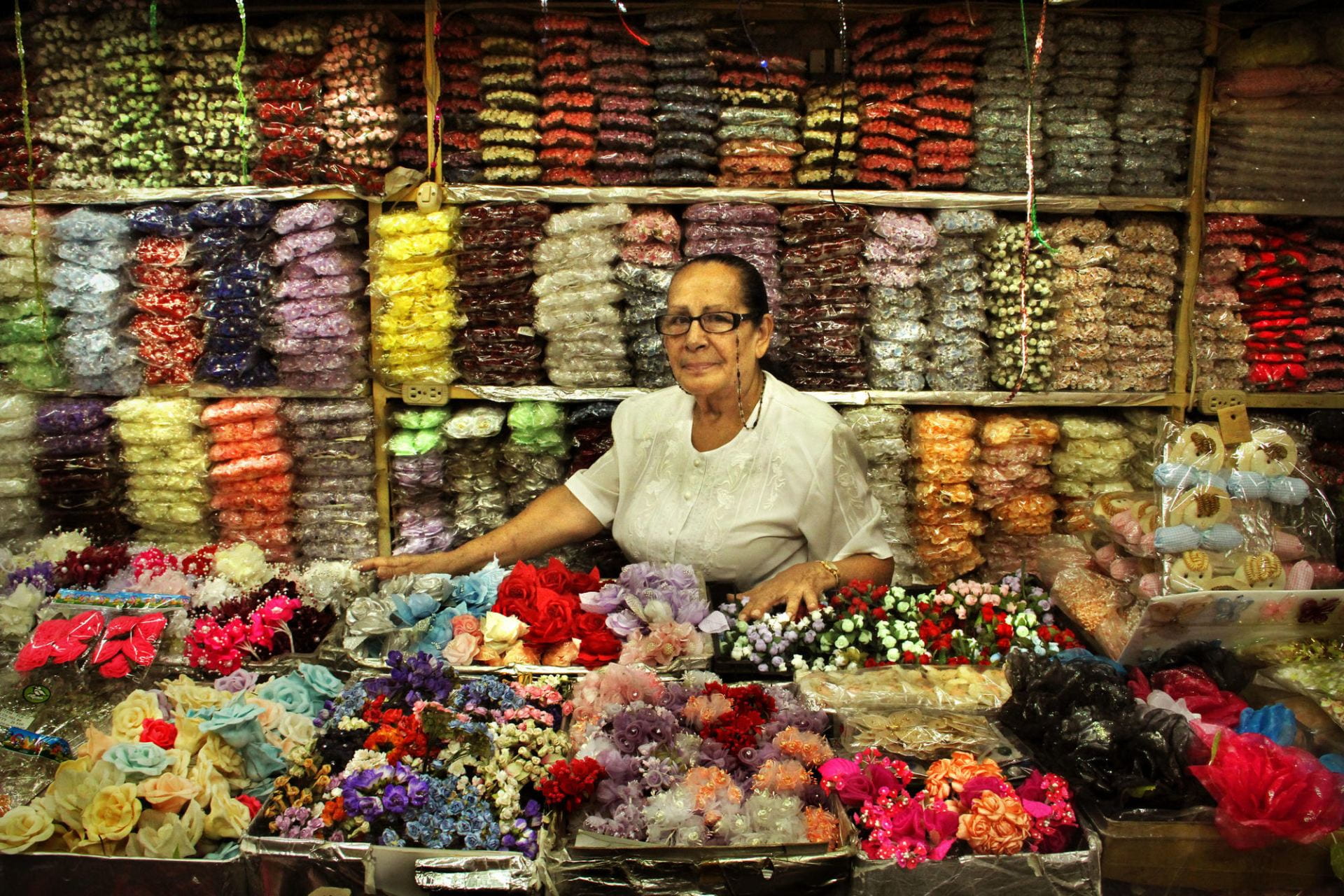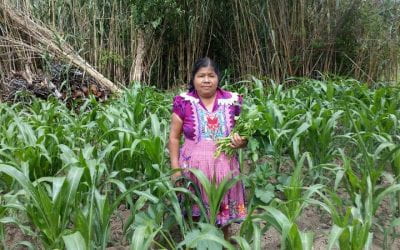The Challenges of an Aging Society
The Case of El Salvador
Photos by Mauro Arias
I remember vividly my trip at the beginning of the century to Morazán, the mountainous region in northern El Salvador that suffered greatly in the 12- year civil war that ended in 1992. As executive director of the government’s Conditional Cash Transfer Program (CCT), I was accompanying a group of experts sent there to collect the basic information about people who could benefit from the first social transfer program targeting families with young children and pregnant women living in villages ranked as some of the poorest in the country.
I was particularly struck by the precarious conditions of an elderly couple who lived in a one-room shack with a ramshackle tin roof. Their only bed was a hammock. The couple did not qualify for the CCT program because they did not have young children. Yet they would benefit from the planned introduction of basic social services such as drinking water. At the time of my visit, they had to drink water from a nearby polluted stream. As a result of this visit and others, I began to look into what social programs were aimed at this very vulnerable population group—the aging.
As I had feared, these programs were very few or even non-existent in rural areas. This led to the idea and later the design of the Pensión Básica Universal (Non-Conditional Social Pension)intended to benefit the highly vulnerable adult population over 70 years old living in serious poverty. To achieve this goal, we used the program of Comunidades Solidarias to help establish the foundations of the Social Protection System in El Salvador in 2009.
El Salvador, like other Latin American and Caribbean (LAC) countries, faces significant challenges in the face of its fast growing aging population. The population over 60 years of age will represent 17 percent of the total in 2030, and 20 percent of the total population in the region by 2050. We need to identify the challenges so we can develop adequate public policies based on solid evidence to prevent further social exclusion and acute poverty on this fast-growing population group.

Ortensia Palma, 74, was a street peddler when she was 15, but five years later managed to get a stall in the market where she specialized in flowers.
Life expectancy in El Salvador is estimated to double in a 100-year period (1950-2050), reaching 80 years in 2050. The steady increase in life expectancy paints a clear idea of the challenge that we already face as a society. More Salvadorans will be over 60 years (from 11.5 % in 2015 up to 24.1% in 2050), and population projections estimate that the number of elderly will double or even triple during the period 2015-2050. The aging index is estimated to jump from 42.4 in 2015to 182.2 in 2050; the number of very elderly (above 80 years of age) is indexed to increase from29.9 in 2015 to 38.3 in 2050, and long-term care from 3.9 in 2015 to 9.3 in 2050 (IDB, 2018).
Social and economic protections for people in the worst conditions of poverty and vulnerability help protect and promote the exercise of the human rights of these groups and to increase social and human capital. At the same time, their access to quality social services such as education, health and drinking water must be improved— measures that impact directly in the human and economic development of a country.
Cash transfer programs implemented in the LAC countries for the last two decades help establish the basis of several Social Protection Systems around the region, including in El Salvador. The design and implementation of these social protection policies is evolving and improving in areas such as institutional coordination of programs, the development of information systems, the targeting and selection of participants, monitoring and evaluation of programs, grievance systems, accountability, and above all, effectiveness.
However, social protection expenditure has not been enough to significantly reduce poverty and inequality. For instance, social safety net spending, as part of social protection, is less than one percent of the Gross Domestic Product (GDP) in El Salvador, compared to other countries like Colombia and Chile that attain percentages of 3 and 3.5 of their GDP respectively (World Bank, 2018). Almost a decade since the Pension Básica Universal (non-contributive) was established in El Salvador, only four out of every hundred persons older than 60 years of age are covered (BID 2017), representing a paltry 0.01% of GDP (World Bank, 2018).
The challenge of population aging in El Salvador is further complicated by social gaps and rifts that have not been bridged since the end of the civil war, 26 years ago. At the same time the country’s population is aging, both internal and international migration has shaped a new model of families and cities that has many implications in terms of social security and pension, health and long-term care. Young people at the height of their productive years migrate for better jobs and, in many cases, to escape violence, leaving some towns filled with elderly and children. The social security and pension services must reflect these new models. We cannot stress enough the importance of an integral reform of the social security and pension system; a system that we can qualify today as fragmented in which multiple systems co-exist and are unsustainable, with a significant tax burden and low coverage (28 % of the economically active population) in a country in which the informal sector nears 70% of the economically active population (Avalos, 2017).
El Salvador’s health system must also be reformed to take into account the challenges of the elderly. Many different health schemes co-exist, and the levels of inefficiency and inequity are high. The importance of an integrated concept of the health system is paramount. Its modernization through technology and information systems and sustainability requires a public-private strategic approach and partnerships among private and public sectors, civil society and communities. This is the key to improve and innovate our health system, mostly at the community level, and particularly as our response to the challenges of an aging population, in which chronic and infectious diseases, as well as long-term care, make increased economic and social demands.
The issue of long term care (LTC) becomes critical in this context. In the LAC region about eight million people (11 % of the population over 60 years of age) are dependent, using the definition of the World Health Organization in which a person is not able to carry on at least one basic task of his or her daily life. In El Salvador this percentage applies to 1.7% of the population (or 28, 000 Salvadorians) The LTC becomes a central issue in the design of integrated and comprehensive public policies that recognize the characteristics and needs of this age group, as well as an evaluation of existing informal care, both in regards to its impact and capabilities on the level of families and community.
In El Salvador, only a small percentage of the elderly benefit from a formal pension (9%), and only 4 % benefit from a universal basic pension (coverage of 4%) Around three out of 10 people over 60 live in conditions of poverty, either extreme poverty—subsisting on less than three dollars a day—or moderate poverty, getting by with three to five dollars a day. About 12% of Salvadorans over 60 live by themselves (BID, 2018).
The efforts to improve social protection and care policies for the aging are still very timid in El Salvador. However, it is important to highlight the importance of initiatives such as the creation of the Inter-American Development Bank’s Observatory on Aging and Care, which will provide relevant information for the design of policies based on empirical evidence.
This generally bleak outlook is not due to the lack of reforms, policy designs and the approval of laws to try and resolve these fundamental problems that we face as a country. The reason for the current situation is that all of the above has been carried out in a very complex social, economical and political context. On top of the ongoing process of strengthening democracy, Salvadoran society has been confronted with serious corruption problems, increasing political polarization, weak governance and institutions as well as unprecedented social violence. All these factors have contributed to slow down and even revert some of the few social advances achieved in the last twenty-five years.
To find and provide the right answers to population aging and quality of life for the elderly in the 21st century, one must study the experiences of some “smart cities” that have introduced innovation and used new information technologies (as well as “big data”) to shed more light on how to find the right answers. We have to remember that our population will be a more urban one in the coming years. According to the United Nations, more than 80 percent of the LAC population will live in cities by 2050. This is an emerging issue in the region and some of its major cities are taking it seriously.
The June 2018 McKinsey Global Institute Report on Smart Cities: Digital Solutions for a More Livable Future reveals that the LAC region lags behind compared to other regions of the world in the implementation of digital solutions, all of which will eventually impact the quality of life for the aging. However, in the region, those cities that deploy more digital solutions and applications have made significant progress in mobility, security, health, public services, economic development, housing and community. Santiago, São Paulo, Mexico City, Bogotá, among others, lead these efforts. The Barcelona winner of the Mayor Challenge Grand Prize, Bloomberg Philanthropies, with the “Vincles” project is a good example. The “Vincles” project (Social Ties) is based on a collaborative approach to care, based on the use of tablets and smartphones, combining both the informal care provided by families and communities and the formal care provided by the health and social services organizations and their experts.
From this perspective, the reform of the pension system and an integrated health system, as well as the introduction of innovation and information technologies, are necessary step towards a quality leap in the care and attention, as well as prevention and long-term care for the elderly. These reforms need to integrate the mechanisms and means to assure the effective enjoyment of human rights, and a dignified life for this increasing segment of the population as well as an integral response to the future challenges that will arise.
This comprehensive and human rights approach will contribute to an effective and coherent response to such a complex issue and assure its sustainability in the long term. The foundation is there with the United Nations international instrument for the protection of the “older population and other human rights protection agreements,” as well as the Sustainable Development Goals (SDG) contained in Agenda 2030, like “No One Will Be Left Behind.” In short, architecture of public policies in the framework of the implementation of the SDG, strengthening the political commitment to an inclusive approach. This new architecture, in this new context, offers us a new opportunity to achieve a turning point in sustainable human development in El Salvador.
However, if we do not resolve long-standing structural weaknesses, we cannot respond adequately to current and future problems that may emerge as a result of globalization and demographic transition. The challenges that have emerged in the 21st century could very well increase and widen social and economic inequalities. We need to give 21st-century answers to 21st-century challenges without forgetting the unresolved issues that we have inherited from the 20th century.
Winter 2019, Volume XVIII, Number 2
Carolina Avalos is an economist and international social policy advisor and former President of the Social Investment Fund in El Salvador. She was a 2015-16 Central American Visiting Scholar at the David Rockefeller Center for Latin American Studies.
Related Articles
Video Interview with Flavia Piovesan
Flavia Piovesan is a member of the Inter-American Commission on Human Rights, Professor of Law at the Pontifical Catholic University of São Paulo and 2018 Lemann Visiting Scholar at the…
Aging: Editor’s Letter
There is no smell of pungent printers ink permeating my office. My interns—Sylvie, Isaac and Marc—are not scrambling to find FedEx boxes to send out ReVista issues to authors and photographers all over the world. I cannot feel the silken touch of the printed page…
A Story of Agricultural Change
Francisca Hernández García, 92, lives in San Miguel del Valle, a town of around 3,000 inhabitants in the Central Valleys of Oaxaca, an hour east of the capital city. She is one of the few remaining…





